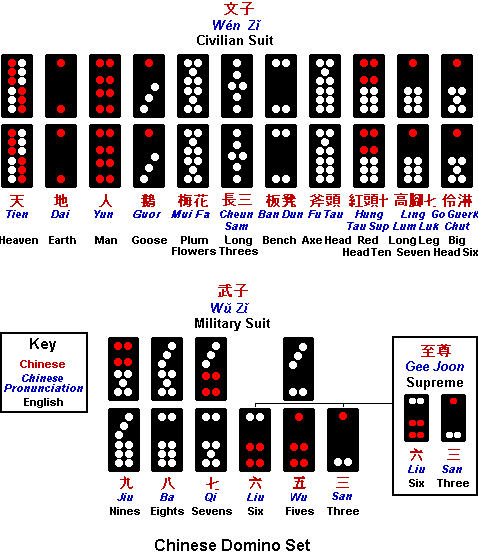|
||||||||||||||||||||||||||||||||||||||||
|
|
||||||||||||||||||||||||||||||||||||||||
|
Chinese Dominoes T he first references to dominoes in China date from 1120 AD, while encounters with Chinese dominoes were reported by Western visitors to the Far-East during the Renaissance. They are still extremely popular in many Asian countries to this day. Learn everything you need to know about Chinese dominoes, here.Chinese dominoes will appear, and are played, in radically different ways to Western dominoes. There are 32 individual tiles in a set and each tile will appear longer/narrower than Western double-square domino tiles, because they are made in a different width/height proportion, so they can be easily held in player's hands like a hand of playing-cards. The size varies but a typical size of a tile maybe around 1-inch wide and 2.5-inches long. They will have no spinner (a rounded metal pin through the middle), like some sets of Western dominoes, which would make it difficult to stack them. In Chinese domino games, players draw tiles from a row of stacked tiles piled on top of each other to a set height which differs depending on the game. The tiles also have no central dividing line separating the spots on either end, but will instead have the two spotted values separated either by distance or clustered in groups or coloured differently. The total number of spots on a tile is most important in the majority of Chinese domino games, where as in the majority of Western domino games the spotted suit value on either end is most important, so ends of Chinese dominoes don't have to be so easily identifiable as their Western counterparts.. The 32 tiles in Chinese domino sets are divided into two different suits: Civilian and Military. There is no obvious and simple way to tell which tiles are in which suit, and players must simply remember which tiles belong to either the Civilian or Military suits. The 22 Civilian tiles rank and are named according to ancient Chinese cultural significance. The 10 Military tiles are ranked and named according to the total number of spots on both ends of a tile. If you want a helpful explanation of how to differentiate the tiles and suits, then try Chinese Domino Identification which explains the meanings and significance of the named tiles, describes methods and tips on identifying suits, and will make it a lot easier to remember the two suits and tile rankings. The picture below illustrates a Chinese domino set and shows the two groupings of suits and the individual tile names. Notice the Military suit is mostly made up of pairs of tiles (known as mixed pairs) with the same total number of spots except for the 6 and 3 which are often paired together and can form their own separate suit known as Supreme.
You may have noted that the one-spots and four-spots are all coloured red. This convention comes from Chinese dice which also traditionally have red one and four-spots. The six-spots on the double-six are marked as three red and three normally coloured spots to help separate the two clustered values on either end. The two-spots are marked horizontally (again a Chinese dice convention) at the extreme end of the tiles, and not diagonally like Western dice and dominoes. The three-spots are usually arranged diagonally except for the double-three which can often be unusually marked as two horizontal spots in the middle of the tile and two pairs of vertical spots on either end. Korean tiles may have a very large one-spot painted red which, again, originates from the marking convention for many Asian dice. Unlike Western dominoes there are no blank suits/ends on Chinese dominoes.It is generally assumed that Chinese Mah Jong game tiles descended from Chinese dominoes. Mah Jong became hugely popular in the West during the 1930s.
|
|||||||||||||||||||||||||||||||||||||||
|
Copyright © 2016 Stormdark I.P. and Media. All rights reserved. www.domino-play.com This site is for personal use only and content may not be copied or reproduced in any form for any purpose. Terms & Conditions Advertising |
||||||||||||||||||||||||||||||||||||||||

